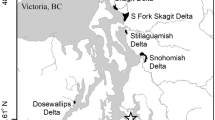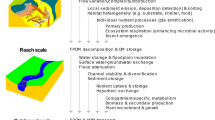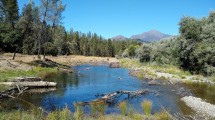Abstract
To provide river managers and researchers with practical knowledge about fish rehabilitation, various studies of fish habitat rehabilitation that used wood were reviewed. The review focuses on fish responses, wood installation methods, and geomorphic features of the rehabilitation sites. Most studies were conducted in moderately sized (small and medium) streams with relatively high bed gradients and aimed to improve the habitats of salmonid species. In this stream type, structures spanning the full (log dam) and partial (log deflector) width of the river were most common, and wood structures that created pools and covers were successful in improving fish habitat. Some projects were conducted in moderately sized low-gradient streams, in which wooden devices used to create instream cover were effective for fish assemblages. There were few studies in other aquatic ecosystems. However, well-designed large wood structures, known as engineered log jams, were used in rehabilitation projects for large rivers. In slack-water or lentic systems such as side-channels, estuaries, and reservoirs, small and large wood structures that created cover were used to improve habitat for many fish species. For successful fish habitat rehabilitation projects, the hydrogeomorphic conditions of rehabilitation sites should be carefully examined to avoid physical failure of wood structures. Although artificial wood structures can be used to improve fish habitat in various aquatic ecosystems, they should be considered to be a complementary or interim habitat enhancement technique. The recovery of natural dynamic processes at the watershed scale is the ultimate target of restoration programs.

Similar content being viewed by others
References
Abbe TB, Montgomery DR (1996) Large woody debris jams, channel hydraulics and habitat formation in large rivers. Regul Rivers Res Manage 12:201–221
Abe T, Nakamura F (1999) Effects of experimental removal of woody debris on channel morphology and fish habitats. Ecol Civil Eng 2:179–190 (in Japanese with English summary)
Akasaka T, Nakano D, Nakamura F (2009) Influence of prey variables, food supply, and river restoration on the foraging activity of Daubenton’s bat (Myotis daubentonii) in the Shibetsu River, a large lowland river in Japan. Biol Conserv 142:1302–1310
Akita M, Makiguchi Y, Nii H, Nakao K, Sandahl JF, Ueda H (2006) Upstream migration of chum salmon through a restored segment of the Shibetsu River. Ecol Freshw Fish 15:125–130
Angermeier PL, Karr JR (1984) Relationships between woody debris and fish habitat in a small warmwater stream. Trans Am Fish Soc 113:716–726
Beechie TJ, Sibley TH (1997) Relationships between channel characteristics, woody debris, and fish habitat in northwestern Washington streams. Trans Am Fish Soc 126:217–229
Beechie TJ, Liermann M, Beamer EM, Henderson R (2005) A classification of habitat types in a large river and their use by juvenile salmonids. Trans Am Fish Soc 134:717–729
Benke AC, Wallace JB (2003) Influence of wood on invertebrate communities in streams and rivers. In: Gregory SV, Boyer KL, Gurnell AM (eds) The ecology and management of wood in world rivers. Symposium 37. American Fisheries Society, Bethesda, pp 149–177
Bilby RE, Ward JW (1991) Characteristics and function of large woody debris in streams draining old-growth, clear-cut, and second-growth forests in southwestern Washington. Can J Fish Aquat Sci 48:2499–2508
Binns NA (1994) Long-term responses of trout and macrohabitats to habitat management in a Wyoming headwater stream. North Am J Fish Manag 14:87–98
Bond NR, Lake PS (2005) Ecological restoration and large-scale ecological disturbance: the effects of drought on the response by fish to a habitat restoration experiment. Restor Ecol 13:39–48
Brooks AP, Gehrke PC, Jansen JD, Abbe TB (2004) Experimental reintroduction of woody debris on the Williams River, NSW: geomorphic and ecological responses. River Res Appl 20:513–536
Brooks AP, Howell T, Abbe TB, Arthington AH (2006) Confronting hysteresis: wood based river rehabilitation in highly altered riverine landscapes of south-eastern Australia. Geomorphology 79:395–422
Bryant MD (1983) The role and management of woody debris in west coast salmonid nursery streams. North Am J Fish Manag 3:322–330
Cederholm CJ, Bilby RE, Bisson PA, Bumstead TW, Fransen BR, Scarlett WJ, Ward JW (1997) Response of juvenile coho salmon and steelhead to placement of large woody debris in a coastal Washington stream. North Am J Fish Manag 17:947–963
Connolly PJ, Hall JD (1999) Biomass of coastal cutthroat trout in unlogged and previously clear-cut basins in the central coast range of Oregon. Trans Am Fish Soc 128:890–899
Crispin V, House R, Roberts D (1993) Changes in instream habitat, large woody debris, and salmon habitat after the restructuring of a coastal Oregon stream. North Am J Fish Manag 13:96–102
Culp JM, Scrimgeour GJ, Townsend GD (1996) Simulated fine woody debris accumulations in a stream increase rainbow trout fry abundance. Trans Am Fish Soc 125:472–479
Daniels MD, Rhoads BL (2007) Influence of experimental removal of large woody debris on spatial patterns of three-dimensional flow in a meander bend. Earth Surf Process Landf 32:460–474
Dolloff CA, Warren ML Jr (2003) Fish relationships with large wood in small streams. In: Gregory SV, Boyer KL, Gurnell AM (eds) The ecology and management of wood in world rivers. Symposium 37. American Fisheries Society, Bethesda, pp 179–193
Everett RA, Ruiz GM (1993) Coarse woody debris as a refuge from predation in aquatic communities—an experimental test. Oecologia 93:475–486
Fausch KD (1993) Experimental analysis of microhabitat selection by juvenile steelhead (Oncorhynchus mykiss) and coho salmon (O. kisutch) in a British Columbia stream. Can J Fish Aquat Sci 50:1198–1207
Fausch KD, Northcote TG (1992) Large woody debris and salmonid habitat in a small coastal British Columbia stream. Can J Fish Aquat Sci 49:682–693
Flebbe PA (1999) Trout use of woody debris and habitat in Wine Spring Creek, North Carolina. For Ecol Manag 114:367–376
Flebbe PA, Dolloff CA (1995) Trout use of woody debris and habitat in Appalachian wilderness streams of North Carolina. North Am J Fish Manag 15:579–590
Floyd TA, Macinnis C, Taylor BR (2009) Effects of artificial woody structures on Atlantic salmon habitat and populations in a Nova Scotia stream. River Res Appl 25:272–282
Frissell CA, Nawa RK (1992) Incidence and causes of physical failure of artificial habitat structures in streams of western Oregon and Washington. North Am J Fish Manag 12:182–197
Giannico GR, Hinch SG (2003) The effect of wood and temperature on juvenile coho salmon winter movement, growth, density and survival in side-channels. River Res Appl 19:219–231
Gippel CJ, O’Neill IC, Finlayson BL, Schnatz I (1996) Hydraulic guidelines for the re-introduction and management of large woody debris in lowland rivers. Regul Rivers Res Manage 12:223–236
Gregory KJ (2003) The limits of wood in world rivers: present, past, and future. In: Gregory SV, Boyer KL, Gurnell AM (eds) The ecology and management of wood in world rivers. Symposium 37. American Fisheries Society, Bethesda, pp 1–19
Hartzler JR (1983) The effects of half-log covers on angler harvest and standing crop of brown trout in McMichaels Creek, Pennsylvania. North Am J Fish Manag 3:228–238
Hilderbrand RH, Lemly AD, Dolloff CA, Harpster KL (1997) Effects of large woody debris placement on stream channels and benthic macroinvertebrates. Can J Fish Aquat Sci 54:931–939
Hilderbrand RH, Lemly AD, Dolloff CA, Harpster KL (1998) Design considerations for large woody debris placement in stream enhancement projects. North Am J Fish Manag 18:161–167
Hindell JS (2007) Determining patterns of use by black bream Acanthopagrus butcheri (Munro, 1949) of re-established habitat in a south-eastern Australian estuary. J Fish Biol 71:1331–1346
Hrodey PJ, Sutton TM (2008) Fish community responses to half-log additions in warmwater streams. North Am J Fish Manag 28:70–80
Inoue M, Nakano S (1998) Effects of woody debris on the habitat of juvenile masu salmon (Oncorhynchus masou) in northern Japanese streams. Freshw Biol 40:1–16
Johnson SL, Rodgers JD, Solazzi MF, Nickelson TE (2005) Effects of an increase in large wood on abundance and survival of juvenile salmonids (Oncorhynchus spp.) in an Oregon coastal stream. Can J Fish Aquat Sci 62:412–424
Jones MJ, Stuart IG (2007) Movements and habitat use of common carp (Cyprinus carpio) and Murray cod (Maccullochella peelii peelii) juveniles in a large lowland Australian river. Ecol Freshw Fish 16:210–220
Kail J, Hering D (2005) Using large wood to restore streams in Central Europe: potential use and likely effects. Landsc Ecol 20:755–772
Kail J, Hering D, Muhar S, Gerhard M, Preis S (2007) The use of large wood in stream restoration: experiences from 50 projects in Germany and Austria. J Appl Ecol 44:1145–1155
Kawaguchi Y, Nakamura F, Kayaba Y (2005) Effects of a re-meandering project on the physical habitats and fish in the Shibetsu River. Ecol Civil Eng 7:187–199 (in Japanese with English summary)
Keim RF, Skaugset AE, Bateman DS (2002) Physical aquatic habitat II. Pools and cover affected by large woody debris in three western Oregon streams. North Am J Fish Manag 22:151–164
Kondolf GM (2000) Some suggested guidelines for geomorphic aspects of anadromous salmonid habitat restoration proposals. Restor Ecol 8:48–56
Kouamélan EP, Teugels GG, N’Douba V, Bi GG, Koné T (2003) Fish diversity and its relationships with environmental variables in a West African basin. Hydrobiologia 505:139–146
Lehane BM, Giller PS, O’halloran J, Smith C, Murphy J (2002) Experimental provision of large woody debris in streams as a trout management technique. Aquat Conserv Mar Freshw Ecosyst 12:289–311
Lehtinen RM, Mundahl ND, Madejczyk JC (1997) Autumn use of woody snags by fishes in backwater and channel border habitats of a large river. Environ Biol Fish 49:7–19
Lester RE, Boulton AJ (2008) Rehabilitating agricultural streams in Australia with wood: a review. Environ Manag 42:310–326
Makiguchi Y, Nii H, Nakao K, Ueda H (2007) Upstream migration of adult chum and pink salmon in the Shibetsu River. Hydrobiologia 582:43–54
Makiguchi Y, Nii H, Nakao K, Ueda H (2008) Migratory behaviour of adult chum salmon, Oncorhynchus keta, in a reconstructed reach of the Shibetsu River, Japan. Fish Manag Ecol 15:425–433
Martin DJ (2001) The influence of geomorphic factors and geographic region on large woody debris loading and fish habitat in Alaska coastal streams. North Am J Fish Manag 21:429–440
McMahon TE, Holtby LB (1992) Behaviour, habitat use, and movements of coho salmon (Oncorhynchus kisutch) smolts during seaward migration. Can J Fish Aquat Sci 49:1478–1485
Moring JR, Nicholson PH (1994) Evaluation of three types of artificial habitats for fishes in a freshwater pond in Maine, USA. Bull Mar Sci 55:1149–1159
Moring JR, Negus MT, McCullough RD, Herke SW (1989) Large concentrations of submerged pulpwood logs as fish attraction structures in a reservoir. Bull Mar Sci 44:609–615
Murphy ML, Heifetz J, Thedinga JF, Johnson SW, Koski KV (1989) Habitat utilization by juvenile pacific salmon (Oncorhynchus) in the Glacial Taku River, Southeast Alaska. Can J Fish Aquat Sci 46:1677–1685
Nagayama S, Kawaguchi Y, Nakano D, Nakamura F (2008) Methods for and fish responses to channel remeandering and large wood structure placement in the Shibetsu River Restoration Project in northern Japan. Landsc Ecol Eng 4:69–74
Nagayama S, Kawaguchi Y, Nakano D, Nakamura F (2009) Summer microhabitat partitioning by different size classes of masu salmon (Oncorhynchus masou) in habitats formed by installed large wood in a large lowland river. Can J Fish Aquat Sci 66:42–51
Nakamura F, Swanson FJ (1993) Effects of coarse woody debris on morphology and sediment storage of a mountain stream system in western Oregon. Earth Surf Process Landf 18:43–61
Nakamura F, Swanson FJ (1994) Distribution of coarse woody debris in a mountain stream, western Cascade Range, Oregon. Can J For Res 24:2395–2403
Nakamura F, Kawaguchi Y, Nakano D, Yamada H (2008) Ecological responses to anthropogenic alterations of gravel-bed rivers in Japan, from floodplain river segments to the microhabitat scale: a review. In: Habersack H, Piégay H, Rinaldi M (eds) Gravel-bed rivers VI: from process understanding to river restoration. Elsevier, Oxford, pp 501–523
Nakano D, Nakamura F (2006) Responses of macroinvertebrate communities to river restoration in a channelized segment of the Shibetsu River, Northern Japan. River Res Appl 22:681–689
Nakano D, Nakamura F (2008) The significance of meandering channel morphology on the diversity and abundance of macroinvertebrates in a lowland river in Japan. Aquat Conserv Mar Freshw Ecosyst 18:780–798
Nakano D, Akasaka T, Kohzu A, Nakamura F (2007) Food sources of Sand Martins Riparia riparia during their breeding season: insights from stable-isotope analysis. Bird Study 54:142–144
Nakano D, Nagayama S, Kawaguchi Y, Nakamura F (2008) River restoration for macroinvertebrate communities in lowland rivers: insights from restorations of the Shibetsu River, north Japan. Landsc Ecol Eng 4:63–68
Näslund I (1989) Effects of habitat improvement on the brown trout, Salmo trutta L., population of a northern Swedish stream. Aquac Fish Manag 20:463–474
Nickelson TE, Solazzi MF, Johnson SL, Rodgers JD (1992) Effectiveness of selected stream improvement techniques to create suitable summer and winter rearing habitat for juvenile coho salmon (Oncorhynchus kisutch) in Oregon coastal streams. Can J Fish Aquat Sci 49:790–794
Piégay H (2003) Dynamics of wood in large rivers. In: Gregory SV, Boyer KL, Gurnell AM (eds) The ecology and management of wood in world rivers. Symposium 37. American Fisheries Society, Bethesda, pp 109–133
Pretty JL, Harrison SSC, Shepherd DJ, Smith C, Hildrew AG, Hey RD (2003) River rehabilitation and fish populations: assessing the benefit of instream structures. J Appl Ecol 40:251–265
Richmond AD, Fausch KD (1995) Characteristics and function of large woody debris in subalpine Rocky Mountain streams in northern Colorado. Can J Fish Aquat Sci 52:1789–1802
Riley SC, Fausch KD (1995) Trout population response to habitat enhancement in six northern Colorado streams. Can J Fish Aquat Sci 52:34–53
Roni P (2003) Responses of benthic fishes and giant salamanders to placement of large woody debris in small Pacific Northwest streams. North Am J Fish Manag 23:1087–1097
Roni P, Quinn TP (2001) Density and size of juvenile salmonids in response to placement of large woody debris in western Oregon and Washington streams. Can J Fish Aquat Sci 58:282–292
Sato T, Sone R, Arizono M, Nagoshi M (2008) Effects of instream structures on Kirikuchi charr, southernmost population of genus Salvelinus, in a small mountain stream of Japan. Fish Sci 74:322–329
Seo JI, Nakamura F, Nakano D, Ichiyanagi H, Chun KW (2008) Factors controlling the fluvial export of large woody debris, and its contribution to organic carbon budgets at watershed scales. Water Resour Res 44:W04428
Shields FD, Knight SS, Stofleth JM (2006) Large wood addition for aquatic habitat rehabilitation in an incised, sand-bed stream, Little Topashaw Creek, Mississippi. River Res Appl 22:803–817
Solazzi MF, Nickelson TE, Johnson SL, Rodgers JD (2000) Effects of increasing winter rearing habitat on abundance of salmonids in two coastal Oregon streams. Can J Fish Aquat Sci 57:906–914
Swales S (1982) Notes on the construction, installation and environmental effects of habitat improvement structures in a small lowland river in Shropshire. Fish Manag 13:1–10
Swales S, O’Hara K (1983) A short-term study of the effects of a habitat improvement programme on the distribution and abundance of fish stocks in a small lowland river in Shropshire. Fish Manag 14:135–144
Sweka JA, Hartman KJ (2006) Effects of large woody debris addition on stream habitat and brook trout populations in Appalachian streams. Hydrobiologia 559:363–378
Toyoshima T, Nakano S, Inoue M, Ono Y, Kurashige Y (1996) Fish population responses to stream habitat improvement in a concrete-lined channel. Jpn J Ecol 46:9–20 (in Japanese with English summary)
Van Den Avyle MJ, Petering RW (1988) Inundated timber as nursery habitat for larval gizzard and threadfin shad in a new pumped storage reservoir. Trans Am Fish Soc 117:84–89
Van Liefferinge C, Seeuws P, Meire P, Verheyen RF (2005) Microhabitat use and preferences of the endangered Cottus gobio in the River Voer, Belgium. J Fish Biol 67:897–909
Van Zyll de Jong MC, Cowx IG, Scruton DA (1997) An evaluation of instream habitat restoration techniques on salmonid populations in a Newfoundland stream. Regul Rivers Res Manag 13:603–614
Warren DR, Kraft CE (2003) Brook trout (Salvelinus fontinalis) response to wood removal from high-gradient streams of the Adirondack Mountains (N.Y., U.S.A.). Can J Fish Aquat Sci 60:379–389
Watanabe K, Nakamura F, Kamura K, Yamada H, Watanabe Y, Tsuchiya S (2001) Influence of stream alteration on the abundance and distribution of benthic fish. Ecol Civil Eng 4:133–146 (in Japanese with English summary)
Wills TC, Bremigan MT, Hayes DB (2004) Variable effects of habitat enhancement structures across species and habitats in Michigan reservoirs. Trans Am Fish Soc 133:399–411
Wright JP, Flecker AS (2004) Deforesting the riverscape: the effects of wood on fish diversity in a Venezuelan piedmont stream. Biol Conserv 120:439–447
Yanai S, Nagasaka Y, Sato H, Ando D (2004) Restoration of stream channel and masu salmon habitat by woody structures in a suburban stream, Central Hokkaido, Northern Japan. Ecol Civil Eng 7:13–24 (in Japanese with English summary)
Zalewski M, Lapinska M, Bayley PB (2003) Fish relationships with wood in large rivers. In: Gregory SV, Boyer KL, Gurnell AM (eds) The ecology and management of wood in world rivers. Symposium 37. American Fisheries Society, Bethesda, pp 195–211
Zika U, Peter A (2002) The introduction of woody debris into a channelized stream: effect on trout populations and habitat. River Res Appl 18:355–366
Acknowledgments
This study was supported by the fund for the “River Ecology Research Group of Japan” on the Shibetsu River and by Grants in Aid for Scientific Research (Nos. 18201008, 19208013) from the Ministry of Education, Science, and Culture, Japan. We thank Dr. Seiji Yanai for providing photos.
Author information
Authors and Affiliations
Corresponding author
Rights and permissions
About this article
Cite this article
Nagayama, S., Nakamura, F. Fish habitat rehabilitation using wood in the world. Landscape Ecol Eng 6, 289–305 (2010). https://doi.org/10.1007/s11355-009-0092-5
Received:
Revised:
Accepted:
Published:
Issue Date:
DOI: https://doi.org/10.1007/s11355-009-0092-5




